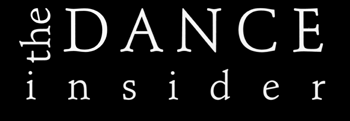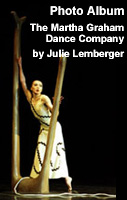
 |

|
 |
 |
 |
 |
 |
Go back to Flash Reviews Parsons Christens Skirball (with a Little Help from Some Friends) By Susan Yung NEW YORK -- New York University's Skirball Center for the Performing Arts opened Thursday, celebrating with a swell-filled house and a program by Parsons Dance Company featuring sparkly guest artists Jenifer Ringer and Angel Corella. Kevin Roche, John Dinkeloo & Associates designed the 850-seat theater, to be used by NYU as well as for music, dance, and theater performances open to the public. L. Jay Oliva, executive producer of the Skirball Center (as well as president emeritus of NYU), in opening remarks noted that "theaters are like religious places," and so began an evening filled with pleasant offerings to the culture gods. NYU's real estate holdings seem to increase all the time, in other parts of Manhattan as well as around its native Village area. (Its latest brush with neighborhood sensibilities, ousting The Bottom Line as a tenant, has provoked the nastiest publicity yet.) The Skirball Center lets the university share this prime location (Laguardia Place at Washington Square South) with the public for the price of a ticket, as the center can be rented for bookings in addition to the university's institutional use. However, the stage is on the shallow side for any dance company larger than the eight which were the most Parsons had onstage at one time, making the house's capacity fairly ambitious financially for small to mid-sized companies. The architects added details to impart a rich feel: two enormous spiraling, gilded columns flank (or should I say outflank) the proscenium; the wall panelling is elaborately carved wood; and the seats are opera house red. The orchestra section sightlines are all good as the house is also shallow, and the upward rake begins not far from the apron. Ringer, a principal with New York City Ballet, performed with David Parsons in the 1999 piece "On a Clear Night," set to music by Ennio Morricone. Ringer wore pointe shoes, while Parsons wore street shoes rather than jazz shoes. This was fitting, as Parsons in recent years has spent a great deal of time pounding the streets, building his company as a viable enterprise, rather than on stage, where he made his name as a dazzling Paul Taylor dancer before forming his own company in 1987. Parsons's reductive ballet sequences posed no great technical challenges for Ringer or himself, but allowed him to demonstrate a protective tenderness toward her. Seeing Ringer in such an intimate setting was a pleasure, and watching Parsons perform once again reminded me of his powerful stage presence. Corella starred in "Caught," Parsons's signature solo in which the dancer appears to be flying through the use of a strobe light. Not surprisingly, Parsons added some multiple pirouettes to the beginning sequence for whirling dervish Corella, and further highlighted the American Ballet Theatre principal's considerable physical skills by adding a series of jumps with his leg orbiting near his ear. Corella could have used more rehearsal to sharpen the timing of the strobe as he was not always at his zenith when the bulb flashed. But again, it was interesting to see such a magnetic and skilled dancer stretch his boundaries a bit more as he has in recent years with collaborations with Parsons and Mark Morris. The program featured additional "best of" highlights from the Parsons repertory. The company crisply performed "The Envelope," a witty piece about a persistent letter; Parsons sprinkled the virtuosic modern movement with memorable visual one-liners. "On a Clear Night" ended with Ringer nestled downstage for a nap that lasted through "Sleep Study," an amusing, rhythmic enchainement of sleeping poses. "Nascimento" was titled in a nod to Milton Nascimento, who created the score as a gift to the company after seeing it perform. Despite a dated feel and a sense of forced gaiety, the work struck an appropriately celebratory tone for an evening filled with promise, if few surprises. |
|||||||


